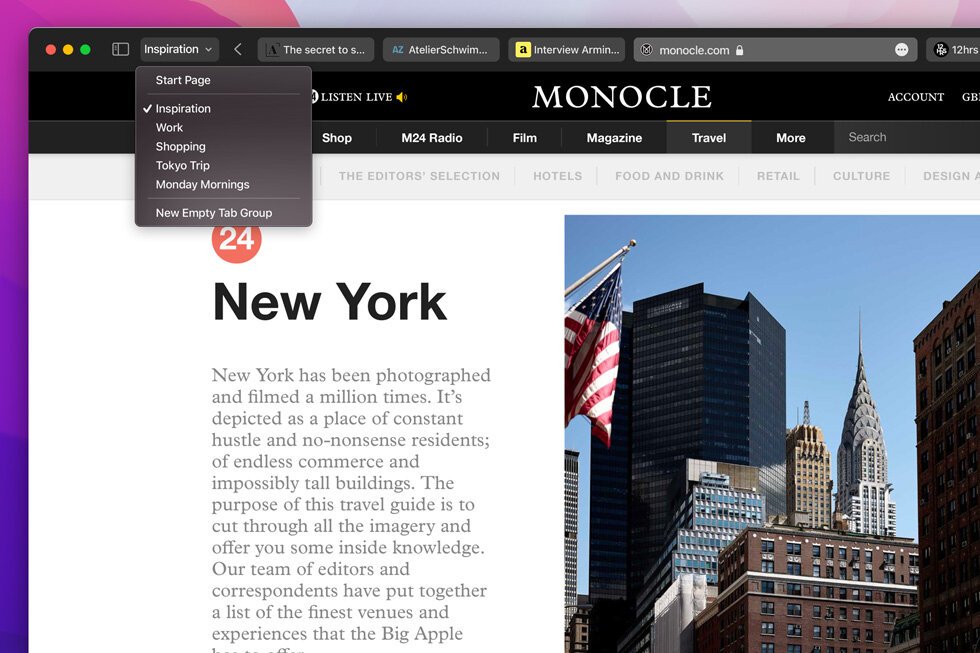Apple has declared macOS “Monterey” for Mac and MacBook complete. The free update presented in June is rather timid compared to the previous year, which brought native support for Apple's own M-series ARM SoCs with macOS 11 Big Sur. Nevertheless, it is called macOS 12. It will be released on October 25th.
Version jump even without a general overhaul
Switching from macOS 10.x to 11 in Big Sur was not only due to the abundance of major changes including ARM support, but Apple now seems to be counting up to the decimal point with every new version every year. However, the manufacturer has only been publicly communicating the name of the operating system for years.
These are the main innovations
With macOS “Monterey”, named after a port city in California, Apple wants to link the Mac (Book) operating system and iPadOS even better. With “Universal Control”, users have the option of controlling the iPad using the keyboard and mouse of a Mac or MacBook – including data exchange.
As early as WWDC 2021, Apple presented on the one hand how the mouse pointer on an iPad positioned next to it was moved with the trackpad of a MacBook, apps were closed and a file was even dragged from tablet to notebook. The chain could be extended: The file could be transferred from the iPad via the MacBook to an iMac placed to the right of the notebook; in this case, it was operated with the mouse.
In this case, the input devices always send their entries to the same system, macOS 12 Monterey forwards the entries either to another computer with macOS or an iPad with iPadOS 15. In contrast to Logitech Flow, for example, the input device does not change the Bluetooth host.
The following end devices support macOS Universal Control:
- MacBook Pro (2016 and later)
- MacBook (2016 and later)
- MacBook Air (2018 and later)
- iMac (2017 and later)
- iMac (5K Retina 27-inch, Late 2015)
- iMac Pro, Mac mini (2018 and later)
- Mac Pro (2019)
- iPad Pro
- iPad Air (3rd generation and later)
- iPad (6th generation and later)
- iPad mini (5th generation and later)
Safari will not be as compact as planned in the end
With macOS Monterey, the Safari browser has once again been given a makeover, whose own control elements should once again shrink for even more website space. Early in the beta, however, Apple dropped the first idea: the URL and search bar were initially positioned to the right of the active tab in the tab bar, i.e. in a constantly changing position. In the final build there are again the familiar two bars by default.
 This is how the tab bar no longer looks in the final build (Image: Apple)
This is how the tab bar no longer looks in the final build (Image: Apple) Monterey receives the new Apple Maps and VRR
Other innovations in macOS Monterey concern universal apps, which are also available for iOS and iPadOS. What changes Apple is planning to make to FaceTime, iMessage, the new Apple Maps or the notification center with SharePlay, Share and Focus can be found in the news on the announcement of iOS 15 and in the report iOS 15: The new Apple Maps is a giant step forward. Monterey also supports Variable Refresh Rate on Adaptive Sync displays.
A complete overview of all new features, including the new tab bar in Safari that has not been implemented, is available already online at Apple.
These Mac and MacBook get the update
Also macOS Monterey is being rolled out by Apple as a free update for some systems that are already very old. The oldest supported Macs are the Mac Pro from 2013. The update will be available on all compatible systems from October 25th.
- iMac ( Late 2015 and later)
- Mac Pro (Late 2013 and later)
- iMac Pro (2017 and later)
- Mac mini (Late 2014 and later)
- MacBook Air (Early 2015 and later)
- MacBook (Early 2016 and later)
- MacBook Pro (Early 2015 and later)